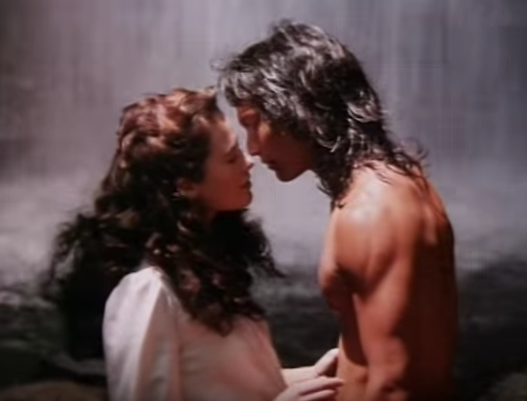'Jungle Book': 8 Things Disney's 1994 Remake Taught Us

Lena Headey and Jason Scott Lee in Disney’s 1994 remake of ‘The Jungle Book’
Disney dusts off The Jungle Book on April 15, when it releases a new take on its 1967 animated fable (loosely based on the Rudyard Kipling short stories that gave it its name) about Mowgli, a young Indian orphan raised in the wild by animals. Director Jon Favreau’s (Iron Man, Zathura) would-be blockbuster will feature computer-generated landscapes and beasts with very familiar voices (Idris Elba, Scarlett Johansson, Bill Murray), alongside a human Mowgli played by newcomer Neel Sethi. What some may not remember, however, is that this isn’t the first time Disney has tried to pump new life into its hand-drawn classic.
In 1994, Disney released a live-action Jungle Book, directed by Stephen Sommers – who’d go on to launch The Mummy franchise starring Brendan Fraser in 1999 – starring Jason Scott Lee, Lena Headey, Cary Elwes, Sam Neill, and John Cleese.
‘Jungle Book’ (1994): Watch the trailer:
It was a reasonably successful and critically well-received work when it arrived, replete with some beautiful Indian settings and copious swashbuckling action. But it hasn’t aged well: Twenty-two years later, it stands as one of the most misbegotten adaptations in recent memory, and serves as a template for all the ways Disney should not re-do its most popular children’s stories. Here are eight key lessons to be learned from this 1994 misadventure:
Hire Children Who Can Act
The 1994 Jungle Book opens with 5-year-old Mowgli (Sean Naegeli) cutely palling around with his pre-adolescent crush Kitty (Joanna Wolff) before an attack on their British expedition’s camp sends the young Indian boy out into the jungle, alone. There, he interacts with black panther Bagheera and bear Baloo, but between his dubbed dialogue and exaggerated faces, Mowgli seems less expressive than the blank-eyed animals he meets.
Related: ‘The Jungle Book’ (2016) Review: Into the Wild With Stunning Digital Effects
Seamlessly Integrate Your Human and Animal Actors On Screen
Sommers relied on lots of camera trickery to convince us that Mowgli (both as a boy and, then, as an adult played by Dragon: The Bruce Lee Story’s Jason Scott Lee) is inhabiting the same space as Bagheera, Baloo, and orangutan King Louie. Those effects, however, are painfully stilted. Moreover, his cuts between close-ups of Mowgli and the animals – which strive to create the illusion that they’re near each other – are so clunkily stitched together that the film never generates any sense of magical wonder from its babe-in-the-woods set-up.
Give Your Animals Real Personalities
Just a year after Jungle Book, in 1995, the far superior Babe showed how to imbue barnyard creatures with genuine personality. The Jungle Book puts almost no effort into establishing the temperament of its key animals (who don’t speak). For example, Bengal tiger Shere Khan’s vacant looks fail to suggest anything like demonic evil, and Baloo comes across as a bland circus animal trained to give a couple of waves and roar on cue.
Related: Meet Bill Murray’s Baloo in Exclusive ‘Jungle Book’ (2016) Clip
Do Not Turn Your Film Into Tarzan
After a brief childhood prologue, the 1994 Jungle Book becomes the story of the grown-up Mowgli, here depicted as a shirtless, long-haired “savage” who’s lost his ability to speak English, and forgotten everything else about modern society. Mowgli soon reconnects with his love Kitty (Headey), who promptly sets about trying to civilize him by teaching him how to wear clothes, read, communicate, and properly stir tea.
In other words, he’s Tarzan, and she’s Jane. Their subsequent saga – fighting colonialists, and achieving harmony with their untamed surroundings – merely further underlines the fact that Sommers’ film, boasting almost no similarities to its source material, is a thinly veiled riff on the King of the Jungle legend.
Do Not Turn Your Film Into Aladdin
Despite its unavoidable Tarzan connections, The Jungle Book also borrows liberally from Disney’s 1992 hit Aladdin. That’s most forcefully felt in a sequence that finds the hero fleeing capture in a crowded marketplace full of stereotypical snake-charming locals. And it also comes via the quest of greedy bad guy Captain Boone (Cary Elwes) to find a magical city of gold – which, naturally, can only be located with Mowgli’s guidance.
Do Not Turn Your Film Into Indiana Jones
That mythical lost metropolis, ruled by King Louie and overflowing with riches, looks like the sort of ancient ruin frequented by Harrison Ford’s famed archeologist from Raiders of the Lost Ark. The fact that, during its finale, The Jungle Book reveals this site to be protected by deadly booby traps – the better to keep materialistic Englishmen from stealing its treasures – indicates that, even before his Mummy movies pilfered the Indiana Jones franchise, Sommers was eager to make his own Spielberg-ish tale.
Avoid Torture
Midway through the 1994 Jungle Book, Mowgli is thrown in a dank dungeon by Elwes’ Boone, where he has the hero beaten by a hired thug. Though this torture is kept off-screen (and firmly establishes Boone’s villainy), it proves a bizarre misstep that jarringly thrusts the film out of kid-friendly territory.
Avoid Sexism
When Kitty becomes engaged to Boone, Mowgli seems puzzled by the concept. John Cleese’s Dr. Julius Plumford (a precursor to John Hannah’s intolerable The Mummy comic-relief sidekick) explains “It means she belongs to him.” Which…well…let’s just say that phrasing it in such a manner might be appropriate for the 19th-century era in which the story takes place, but it seems an odd way to define marriage for young modern audiences.
